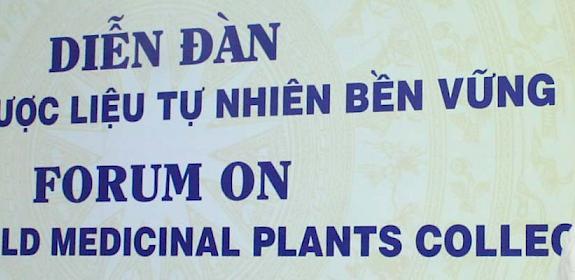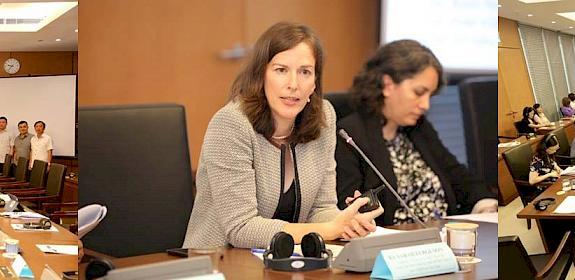CPW experts in Sustainable Wildlife Management discuss Opportunities in the Post-2020 Global Biodiversity Framework
A hybrid online and in-person event invited international experts on sustainable wildlife management to debate issues such as zoonotic disease and the One Health approach, human-wildlife conflict, food security and livelihoods and how best these can support sustainable wildlife management in the Post-2020 Global Biodiversity Framework (GBF). Representatives discussed opportunities around specific targets and the vital indicators needed to ensure the safe, sustainable and legal harvest, use and trade in wildlife and halt biodiversity decline by 2030.
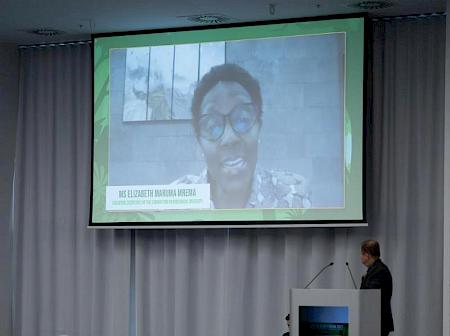
On 26-27 September, over 300 experts came together at the Third Wildlife Forum of the Collaborative Partnership on Sustainable Wildlife Management (CPW) on the sidelines of the 67th General Assembly of the International Council for Game and Wildlife Conservation (CIC) in Budapest, Hungary. TRAFFIC’s Roland Melisch, Director Strategic Partnerships and Vice-Chair of the CPW, opened the forum themed Supporting the implementation of the Post-2020 Global Biodiversity Framework.
We have an important opportunity to highlight sustainable wildlife management as an essential tool to conserve and sustainably use biodiversity. Likewise, [it is] an instrumental means to maintain and enhance ecosystem services and to deliver benefits for people. It is vital that the new biodiversity framework considers the different uses, drivers, impacts and perceptions of wildlife and their management.”
Ms Elizabeth Maruma Mrema, Executive Secretary of the Convention on Biological Diversity (CBD)
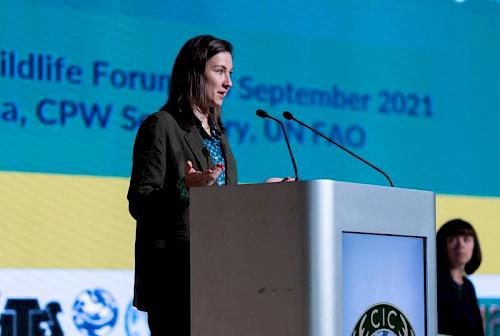
A recurring talking point throughout was the need for robust indicators and practical monitoring frameworks in order to determine the success of conservation efforts over the coming years. As highlighted in TRAFFIC’s key recommendations on the current draft of the GBF, the headline and component indicators for the ambitious Targets 5 and 9 are not yet sufficient, will require substantial resources for effective implementation and could result in a similar inability to reach the goals by 2030 – as seen in the previous CBD framework.
Anastasiya Timoshyna, TRAFFIC’s Senior Programme Coordinator – Sustainable Trade, noted that the baseline ecological data is vital to implementing robust indicators and practical monitoring frameworks. She gave examples of practical tools, that could be applied to monitoring frameworks within multiple GBF Targets. These included regulatory and non-regulatory measures (such as the implementation of standards and traceability approaches, as well as the engagement of non-traditional actors, such as private sector) to support the implementation and measuring the progress of GBF.
In addition to this, Ms Timoshyna highlighted the benefits and costs of sustainable wildlife management but also the disconnect between the narratives on sustainable wildlife management, sustainable consumption and consumer demand.
Ms Timoshyna said: “The CPW and its partners could offer substantial access to data on wildlife trade, use and harvest that would provide an excellent opportunity to support the delivery of Target 5."
Also high on the agenda were the narratives surrounding wildlife use and trade and its links to zoonoses and human health. During the forum session on Zoonotic Disease and the One Health Approach, Dr Richard Kock, Royal Veterinary College, UK and co-chair of the IUCN-SSC Wildlife Health Specialist Group called attention to the preliminary findings of the IUCN Species Survival Commission's Highlights from the Situation analysis on the roles and risks of wildlife in the emergence of human infectious diseases, released at the IUCN World Conservation Congress. He noted that wildlife in situ is rarely a source of disease, and anthropogenic factors tend to be the major drivers of this risk.
Wildlife should not be blamed, over-researched or persecuted for an issue that is primarily in the human domain.”
Dr Richard Kock, Royal Veterinary College, UK and co-chair of the IUCN-SSC Wildlife Health Specialist Group
Dr Kock highlighted the key issue that data and narrative are highly confused and poorly evidenced and suggested that health agendas have been driven for a number of years and are based on an overestimated role of wildlife as a proximate and direct cause of human disease. To tackle this, even as a precautionary principle, he promoted the importance of better monitoring and regulation in wildlife trade for health security and should be the responsibility of public health and veterinary agencies.
He determined, “Pandemics is because we have one world now. The solution to this, I think, is moving away from emergency medicine, moving away from the medicalisation of these things and getting down into what I see as the important part of one health, which is the structural aspects; the political economy, how we live, how greedy we are, how we share our planet and how we eat our food. If we get those things right, I think we’ll solve it.”
Panellists agreed that practical solutions will be essential, including exploring approaches that are already working. These included insights from case studies presented by James Compton, TRAFFIC’s lead on the USAID-funded Wildlife TRAPS Project, on the potential adaptation of existing food safety-critical control points to identify hazards and manage disease risks associated with wildlife trade as a practical approach to preventing future zoonotic spillover events.
Existing Critical Control Point (CCP) based systems used in wild animal supply chains show potential for wider adaptation to allow disease risks be identified, assessed, and mitigated and depending on the context, ideally work in tandem with existing wildlife trade regulations to ensure legality and sustainability.”
James Compton, TRAFFIC’s lead on the USAID-funded Wildlife TRAPS Project
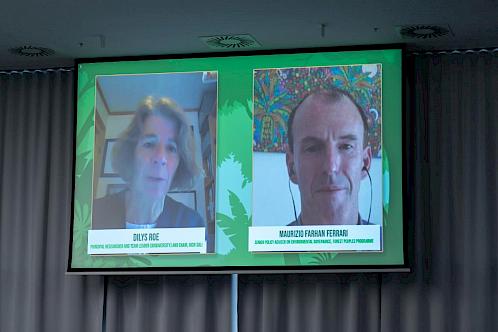
In addition to protecting lives, safeguarding livelihoods and increasing food security should be high priorities in the GBF. Hollie Booth, University of Oxford and Technical Advisor, Wildlife Conservation Society (WCS), stated, “Wildlife use can both help and hinder the delivery of health, livelihoods and nature conservation and policy goals.”
As a result of the pandemic, many have called for blanket bans on wild meat trade. Ms Booth indicated that the removal of wild meat from global food systems may lead to significant land-use changes to an area equivalent to the size of Greece (124,000 km2), which could threaten 250 species. She also advised that removing this availability of meat in certain regions could lead to protein deficiencies in local populations.
Maurizio Farhan Ferrari, Senior Policy Adviser on Environmental Governance, Forest Peoples Programme, proposed additional wording in the indicators concerning ‘customary sustainable use’ in the harvest, use and trade of wildlife. He called for better, equitable participation of Indigenous Peoples and Local communities and capacity building to address this issue be built into the GBF.
It is a challenge to develop targets on sustainable use that are science-based and quantitative, but this partnership brings together the expertise that can help us to do that."
David Cooper, Deputy Executive Secretary at CBD, in his closing address
Notes:
- IISD CPW Wildlife Forum Summary
- TRAFFIC Post-2020 key recommendations
- Existing Food Safety systems could be adapted to reduce wildlife trade health risks
- TRAFFIC COVID-19 Resource Centre
- Sustainable Wildlife Management Beyond 2020 –Consultative Workshop proposed datasets and indicators, and regulatory and non-regulatory measures were discussed.
- Biodiversity for Food and Medicine Indicator (under the Biodiversity Indicators Partnership) was presented as a useful indicator particularly for Target 9.
- CPW guiding principles for reducing zoonotic diseases risks
Watch all the Third CPW Wildlife Forum on CIC Youtube Channel
About Collaborative Partnership on Sustainable Wildlife Management (CPW):
The Collaborative Partnership on Sustainable Wildlife Management (CPW) is a voluntary partnership of 14 international organisations with substantive mandates and programmes to promote the sustainable use and conservation of wildlife resources. The CPW, established in March 2013 in Bangkok, Thailand, provides a platform for addressing wildlife management issues requiring national and supra-national responses and works to promote and increase cooperation and coordination on sustainable wildlife management issues among its members and partners.
The mission of the CPW is to increase cooperation and coordination on sustainable wildlife management issues among its members, where such collaboration adds value, in order to promote the sustainable management of terrestrial vertebrate wildlife in all biomes and geographic areas, contributing to the conservation and sustainable use of biodiversity, and to human food security, livelihoods and well-being. CPW has the following thematic priorities:
- wildlife, food security and livelihoods: provision of knowledge and support for members and countries to address wildmeat and other issues related to wildlife, food security and sustainable livelihoods.
- human-wildlife conflict: improved understanding of the direct and underlying causes of such conflicts in the different regions of the world; dissemination of successful response mechanisms.
- illegal/unsustainable hunting: support the development of strategies, policies, and management systems that contribute to legal and sustainable hunting; support appropriate efforts to combat poaching and other forms of illegal hunting;
- zoonotic diseases and health-related issues: joint efforts to reduce the risk of future pandemics originating from wild animals, and the strengthening of the conservation of wildlife; and
- partnership coordination and outreach: consolidation of the CPW; building understanding, conveying common messages on issues of global relevance related to sustainable wildlife management.
The event took place in the margins of the One with Nature (OWN) exposition. The CPW is grateful to OWN who generously provided the funding for the CPW Wildlife Forum’s participation.
Special thanks to David Kovacs for providing the images.


